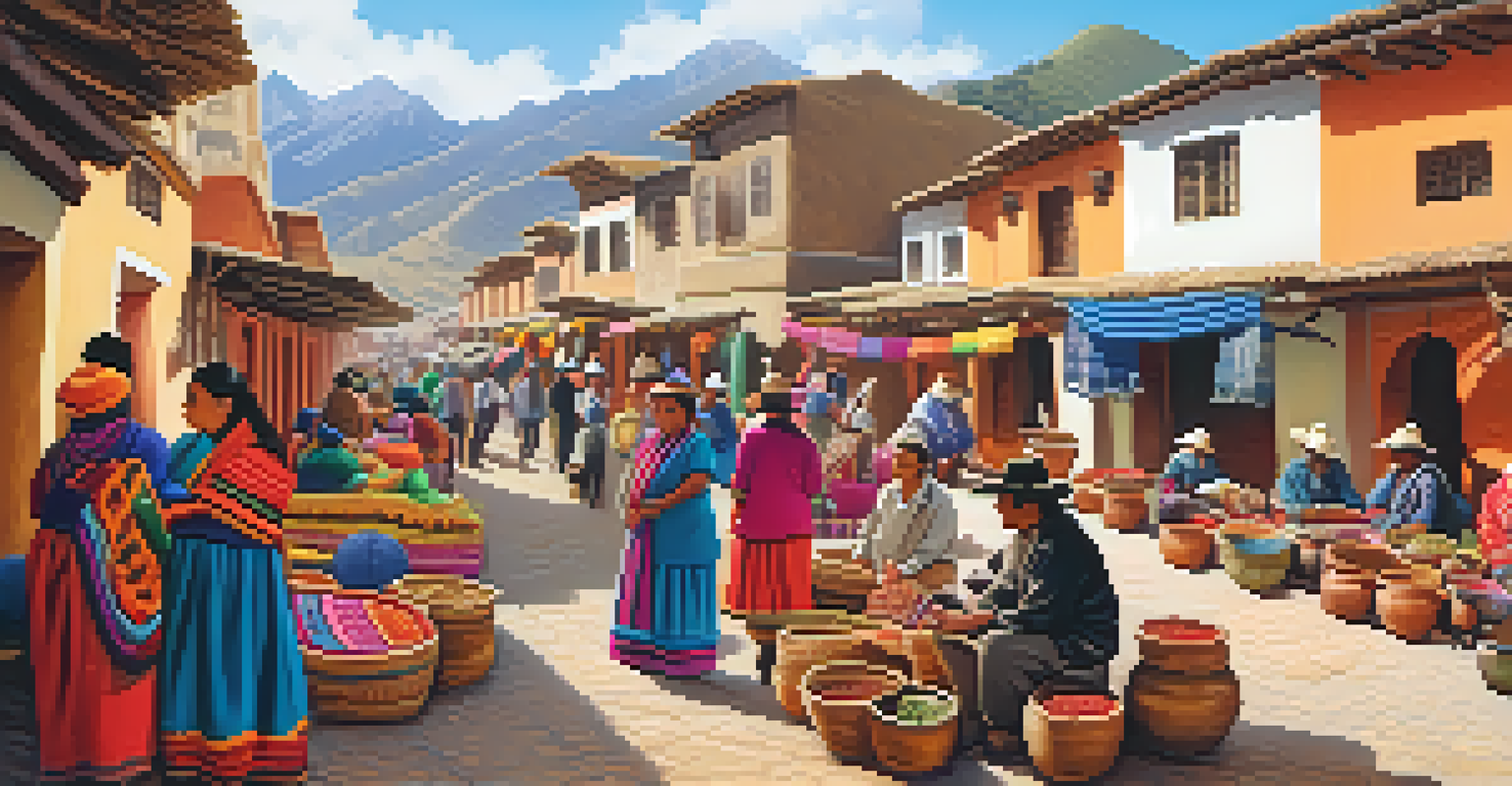The Role of Indigenous Voices in Contemporary Peruvian Writing

Understanding the Diversity of Indigenous Cultures in Peru
Peru is home to a rich tapestry of Indigenous cultures, each with its own unique history, language, and traditions. From the Quechua and Aymara to the Amazonian tribes, these groups contribute to the country's cultural diversity. This plurality not only enriches the national identity but also offers a multitude of perspectives that are increasingly being reflected in contemporary literature.
We must strive to preserve the voices of Indigenous people, for they hold the key to understanding our past and shaping our future.
The varying worldviews and experiences of these Indigenous communities shape how stories are told. For instance, the connection to land and nature is a recurring theme in their narratives, often contrasting with urban experiences. This duality helps readers appreciate the complexities of Peruvian society and its historical context.
As more Indigenous authors gain prominence, their voices provide a platform for discussing issues such as cultural preservation, environmental challenges, and social justice. This dialogue is essential in fostering understanding and respect for Indigenous rights within the broader literary landscape.
The Rise of Indigenous Authors in Modern Literature
In recent years, there has been a notable increase in the number of Indigenous authors emerging in Peru. Writers like María José Núñez and Juan José Flores have begun to carve out significant spaces for their narratives, drawing upon their cultural heritage. This shift is crucial not just for representation, but also for challenging the dominant narratives that have historically sidelined Indigenous experiences.

These authors often blend traditional storytelling techniques with contemporary themes, creating a unique literary style. This fusion allows them to engage with modern readers while still honoring their heritage. It’s like weaving a modern tapestry from ancient threads, showcasing both past and present.
Indigenous Voices Shape Literature
Emerging Indigenous authors in Peru are redefining narratives, blending cultural heritage with contemporary themes.
Through their works, Indigenous writers illuminate the complexities of identity and the struggles faced by their communities today. Their stories resonate beyond Peru, inviting a global audience to reflect on Indigenous issues and the importance of cultural narratives in a modern world.
Themes of Identity and Belonging in Indigenous Literature
A central theme in contemporary Indigenous literature is the exploration of identity and belonging. Authors often grapple with their dual existence—navigating between traditional Indigenous ways of life and the influences of modernity. This internal conflict is relatable to many readers, making their stories resonate on a personal level.
Language is the road map of a culture. It tells you where its people come from and where they are going.
For instance, many narratives depict characters who return to their ancestral roots, seeking to reconcile their heritage with contemporary life. This journey of self-discovery mirrors the experiences of individuals from diverse backgrounds, highlighting universal themes of belonging and acceptance. It’s a reminder that identity is often fluid and multifaceted.
By sharing these personal stories, Indigenous authors invite readers to reflect on their own identities and the importance of cultural connections. This not only fosters empathy but also encourages a deeper understanding of the complexities that shape our societies.
Environmental Concerns in Indigenous Narrative
Indigenous literature often addresses pressing environmental issues, reflecting the deep connection these communities have with their land. Authors bring attention to ecological degradation and climate change, issues that disproportionately affect Indigenous populations. This focus serves as a powerful reminder of the importance of sustainability and respect for nature.
For example, many narratives highlight traditional ecological knowledge, showcasing how Indigenous practices contribute to environmental stewardship. This knowledge is invaluable in today’s climate crisis, as it offers alternative ways of living that prioritize harmony with the earth. It’s like drawing from an ancient well of wisdom to find solutions for modern problems.
Identity and Belonging Explored
Contemporary Indigenous literature delves into themes of identity and belonging, resonating with universal human experiences.
By weaving environmental themes into their narratives, Indigenous authors not only advocate for their communities but also educate readers about the interconnectedness of all life. Their stories challenge us to rethink our relationship with nature and consider the consequences of our actions.
The Role of Language in Indigenous Literature
Language plays a vital role in Indigenous literature, serving as a vessel for cultural expression and identity. Many contemporary authors incorporate Indigenous languages into their works, celebrating their linguistic heritage while also making a statement about cultural survival. This practice enriches the narrative and invites readers to engage with the text on a deeper level.
Moreover, the use of Indigenous languages often emphasizes the connection between language and worldview. Different languages encapsulate unique ways of seeing the world, which can be lost in translation. For example, certain concepts in Quechua or Aymara may not have direct equivalents in Spanish or English, highlighting the richness of Indigenous thought.
By embracing their languages, Indigenous authors empower their communities and affirm the significance of their cultural narratives. This not only preserves their linguistic heritage but also fosters a sense of pride and belonging among readers who share that cultural background.
Contemporary Issues and Social Justice in Indigenous Writing
Many Indigenous authors use their platforms to address contemporary social justice issues, including land rights, discrimination, and cultural appropriation. These themes are woven into their narratives, reflecting the real struggles faced by Indigenous communities in Peru. Literature becomes a powerful tool for advocacy, enabling authors to raise awareness and inspire change.
Through storytelling, these writers confront the historical injustices that continue to impact their lives. Their works serve as a call to action, urging readers to acknowledge and address these issues. It’s like holding up a mirror to society, reflecting the challenges that need to be faced collectively.
Environmental Issues Highlighted
Indigenous narratives often address environmental concerns, emphasizing the connection between cultural practices and ecological sustainability.
By bringing these contemporary issues to light, Indigenous authors not only foster empathy but also encourage readers to engage in conversations about justice and equality. Their narratives are essential for promoting awareness and pushing for systemic change in society.
The Future of Indigenous Voices in Peruvian Literature
The future of Indigenous voices in contemporary Peruvian literature looks promising as more writers gain visibility and recognition. Literary festivals and platforms dedicated to Indigenous literature are emerging, providing spaces for these voices to be heard. This growing support is crucial for the continuation of Indigenous storytelling traditions.
As new generations of Indigenous writers emerge, they bring fresh perspectives and innovative narratives that reflect the changing landscape of Peru. These writers are not only preserving their cultural heritage but also adapting it to address modern challenges. They are like seeds planted in rich soil, ready to bloom into diverse narratives that captivate audiences.

The continued celebration and promotion of Indigenous literature will play a vital role in shaping Peru's literary future. By amplifying these voices, we can ensure that the rich traditions and stories of Indigenous communities are honored and shared with the world.